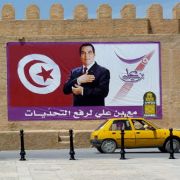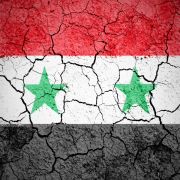The Syrian War: Another 10 Years?
by Paul Rivlin
Iqtisadi: Middle East Economy, Volume 4, Number 4 - Moshe Dayan Center for Middle Eastern and African Studies
This edition of Iqtisadi examines the destruction inflicted by war on Syria and its people, the development of a war economy, and the crucial role of external powers in prolonging the conflict. It will show how the conflict may continue despite the enormous amount of damage generated so far.
One UN estimate of damage to the economy in the first two years of conflict is over $84 billion. If the conflict ceased now and gross domestic product (GDP) grew at an average rate of 5 percent each year, it is estimated that it would take the Syrian economy 30 years to return to the level of 2010. GDP in 2014 may fall to about $30 billion, less than half of its 2011 level; on this basis, GDP per capita will decline from $2,870 to $1,430. Unemployment is reported at 50 percent and one of the backbones of the economy – agriculture – now faces the renewed threat of drought. Half of the population is now living below the poverty line, with 4.4 million in extreme poverty.
The 2014 wheat harvest is likely to be the lowest since the severe drought of 2008, the result of poor winter rainfall and the impact of the conflict. The 2008 drought caused the wheat harvest in that year to fall to 2.1million tons, compared with an annual average of more than 4million tons in the previous five years. Poor rainfall from 2009 to 2011 meant that production averaged only about 3.5 million tons. The benefits of better rainfall in the winters of 2011/12 and 2012/13 were offset by the effects of the conflict, as farmers struggled to obtain fuel, seeds, and fertilizer, and transportation was severely disrupted. Wheat production fell to 2.8 million tons in 2012 and to 2.4 million tons in 2013. The UN's World Food Program (WFP) suggests that as a result of the poor rainfall and the reduction in the planted area, the 2014 harvest could be as low as 1.7 million to 2 million tons.
After being the only country in the region that was self-sufficient in food production, Syria has become a net importer of wheat. Before the uprising, Syria had a strategic wheat reserve of about 3.5 million tons, equal to one year’s consumption, and mostly stored in areas that are now outside the regime's control. In 2013, the government is reported to have imported about 2.4 million tons of wheat.
Most Syrians are now dependent on government subsidies and foreign aid for much of their basic consumption. The 2014 budget included an allocation of S£615 billion ($4.5 billion) for subsidies, 44 percent of total expenditure. Food and healthcare aid supplied by UN agencies provides an important supplement to the government's activities. The regime can to turn this aid to its advantage in its conflict with rebel forces, as UN agencies distribute these goods and services through official channels. The WFP has increased its estimate of the number of Syrians that it will need to supply with emergency food aid during 2014, from 4.2 million to 6.4 million but has reduced the size of its food parcels by 20 percent in response to higher demand and a lack of funding.
The destruction of the irrigation system will have long lasting effects on agricultural production. As conflict continues, low production levels will become a permanent feature and agriculture will remain exposed to inter-annual variations in rainfall. Production from the summer growing season has already been very severely reduced. This situation will not change while conflict lasts and its resolution will take considerable time if and when peace is restored.
The war, coupled with the impact of economic sanctions, has caused a steep economic decline, loss of jobs and livelihoods, and increasing vulnerability among large segments of society. In addition to increasing poverty, there has been massive destruction of housing and infrastructure, including water and power utilities, schools, medical, and other social service facilities, industrial and agricultural infrastructure, including fertilizer production and the pharmaceutical industry. Fuel shortages have affected the whole economy including electricity and water supplies, distribution and waste water management, transportation and irrigation systems, and disruptions to telecommunications. Private sector activity, especially in the informal sector — which employs a large proportion of the population — has been badly hit, leading to unemployment in industry, agriculture, and tourism. Unsafe movement on major routes in the country and across borders hinders internal and external transit and trade and inflates prices. Accelerating inflation due to the rising costs of imports has resulted from the devaluation of the local currency.
In March 2014, the UN stated that an estimated 150,000 had been killed in the Syrian civil war. On 15 March there were 2,563,434 officially registered refugees and others awaiting registration. At the end of December 2013, there were 6.5 million displaced people inside Syria; by March 2014 that number had reached 7.3 million. The number of internally displaced has been unofficially estimated at over 8 million people. The largest reported displacement – at up to 650,000 – has been in Aleppo. A further 160,000 have fled from the Dar‘a governorate, while around 50,000 are reported to have been displaced within rural Damascus and over 35,000 in Quneitra. The large-scale displacement within Aleppo Governorate has significantly increased the number of people in need of food assistance, with 1.25 million people estimated to be in need in rural and eastern areas of the governorate.
The number of refugees is forecast to rise to 4.1 million by the end of 2014, with 1.65 million in Lebanon, 800,000 in Jordan, 1 million in Turkey, 400,000 in Iraq, and 250,000 in Egypt.
This has been the most destructive war since that between Iran and Iraq which lasted eight years. Although President Assad claims that the "active war" is over, his forces control only about 40 percent of the country and fighting continues. Given this, some have suggested that the war could go on for another ten years. How is this possible given the enormous destruction that has already occurred? Internal and external factors are involved.
 Pictured: Destruction in Azaz, Syria. Credit: Christiaan Triebert via Wikimedia Commons
Pictured: Destruction in Azaz, Syria. Credit: Christiaan Triebert via Wikimedia Commons
The conflict has created a war economy, or, to be more accurate, a series of war economies. These are benefiting various groups who have incentives to maintain the country in a state of conflict.
The government has maintained spending on the armed forces and the civil service, and continues to provide basic commodities at subsidized prices in the areas it controls. In opposition controlled areas (as well as in some government controlled ones) looting, kidnapping, and smuggling have all become sources of income. New military elites have become economically established and seized assets such as oil fields, border crossing points and other checkpoints (where transit fees can be imposed), grain storehouses, and even branches of the central bank of Syria. Northeast Syria, which was the country's bread-basket and contains its energy reserves, has become a separate economy largely run by the Kurdish minority, but threatened by groups connected with al-Qaeda.
Battles have been lengthened to generate external funding provided by Gulf States to the rebels. The breakdown of government control in much of the country has encouraged smuggling of goods – such as used cars – that are officially banned. The government has come to rely on local militias that have been able to assert local autonomy and acquire economic assets. Western sanctions against the state and prominent personalities associated with it, has encouraged others to become intermediaries, often operating through Lebanon. All these groups and individuals are benefiting from the war and have interests in it continuing.
More significantly, the Assad regime has survived because of the aid that it has received from Iran and Russia. In May 2013, Iran signed an agreement with Assad to supply Damascus with $ 3.6 billion in oil. The agreement stipulates that the Syrian government will have to pay back the cost of the Iranian oil loans through Iranian investments in Syria, details of which have not been specified.
This oil deal was part of a package to extend Iranian aid to Assad's regime which is Iran's only regional ally. In addition to the $3.6 billion aid in oil, another $1 billion credit line to Damascus has already been extended. Moreover, Iran had previously signed a free trade deal that granted Syrian exports as low as 4 percent customs tariff. These moves have been taken to enable Syrian authorities to buy Iranian power-generating products and other goods in the framework of a barter arrangement. In addition, in January 2013, when the Syrian prime minister visited Tehran, Iran reportedly deposited $500 million in Syria's central bank.
International sanctions, including those from the United States and Europe, have intensified on Assad's regime. As a result, Damascus has become short of diesel and fuel for its army and for the economy. Iran has been attempting to negate international sanctions by supplying oil, fuel and petroleum products, as well as military and intelligence support.
According to the then deputy prime minister for economic affairs, Qadri Jamil, in 2013, Iran, Russia, and China were propping up Syria’s economy, with $500 million a month in oil and extending credit lines. Syria had an unlimited credit line with Tehran for food and oil-product imports. Ships “under the Russians flag” were delivering oil products to Syria’s government-controlled coast.
Russia has also provided Syria with arms and military advisors. There are several reasons for this apart from the traditional close relations between the two states that go back to Soviet times. Russia has a large arms industry and war is good for business. In 2011, it exported around $1 billion worth of arms to Syria, and there are some $4 billion in outstanding contracts.
As Syria’s manufacturing sector crumbles under the weight of sanctions, years of mismanagement, and war, the regime depends on imports of petroleum products, grains, electrical equipment and other Russian goods. In 2011, trade between Syria and Russia increased by 58 percent to $1.97 billion, according to Russian sources.
The most tangible prize for Moscow is access to a naval base in Syria’s port city of Tartous; it is Russia’s only navy outpost in the Mediterranean. In 2008, Tartous was converted into a permanent Russian base, with ambitious plans for modernizing its facilities. At the end of 2013, Syria and Russia signed a deal to explore for oil and gas in Syrian territorial waters, where the size of the reserves are undetermined. The two countries agreed on a 25-year deal, funded by Russia, which will recoup its costs if oil and or gas is found.
There are also broader issues at stake. Non-interference in internal affairs of sovereign states is one of central tenets of Russia’s diplomacy. Like China, Russia feels this principle was blatantly violated by NATO’s 2011 campaign against Libya's leader Muammar al-Qaddafi and by the US invasion of Iraq in 2003.
For Moscow, regime change in Syria is a red line, and it will veto any UN Security Council resolution that comes close to authorizing an international military intervention against Assad. Russia's foreign policy values stability above all else: it views the Arab Spring as a failure that has let loose dangerous Islamist extremism. The Kremlin worries that the fall of Assad would hasten that trend, and many in the West also fear a Syria controlled by Islamic forces. Current tension between Russia and the West over Ukraine will, if anything, strengthen Russia’s support for Syria. This can be interpreted as defiance of the US and also a reflection of the Kremlin’s opposition to those Islamic forces that it sees as a threat to its own territorial integrity.
Can the war in Syria go on for another 10 years, as some in Washington believe? There are precedents: the Iran-Iraq war lasted eight years and caused hundreds of thousands of deaths, huge destruction, and was followed by two wars against Iraq led by the US, in 1991 and 2003. Iraq has been beset by internal conflict ever since. The Lebanese civil war lasted 15 years between 1975 and 1990: 150,000 people were killed, another 100,000 were permanently handicapped, and about 900,000 people were displaced from their homes, and at least a quarter of a million emigrated.
The precedents for prolonged disruption in Syria are there, and both internal and external dynamics suggest that this may be Syria's fate for some time to come.
 Iqtisadi: Middle East Economy is a monthly e-newsletter providing subscribers with economic analysis of key players and events affecting the marketplaces and societies of the Middle East.
Iqtisadi: Middle East Economy is a monthly e-newsletter providing subscribers with economic analysis of key players and events affecting the marketplaces and societies of the Middle East.






